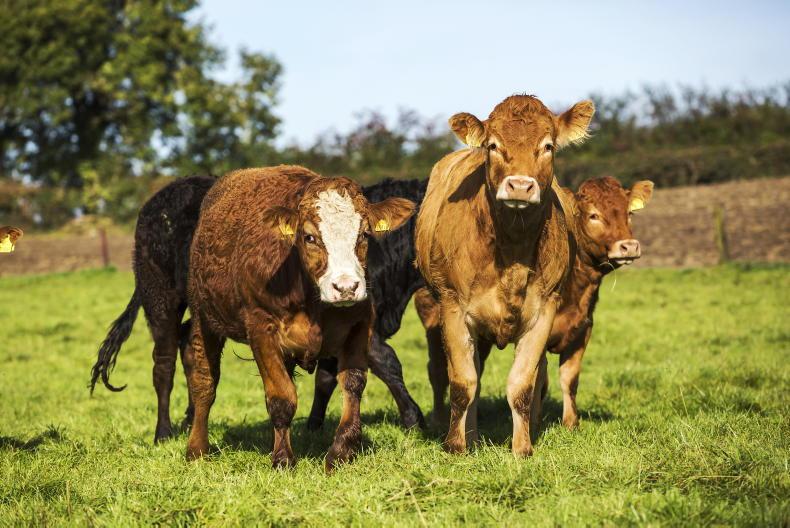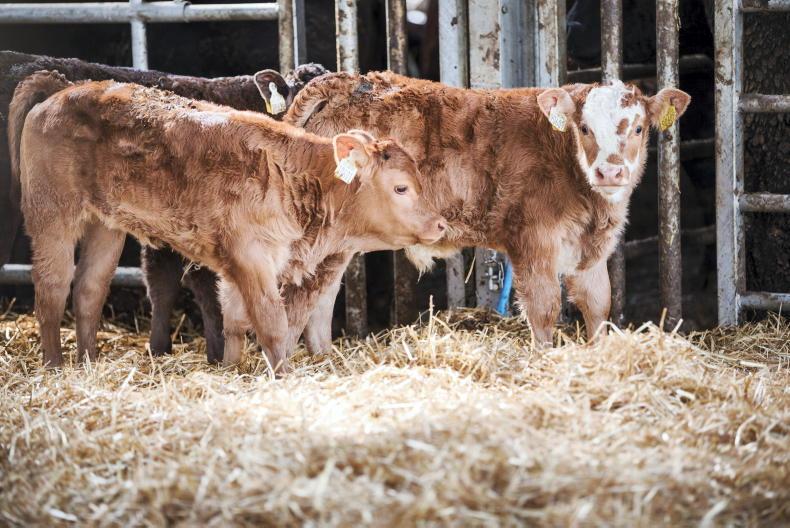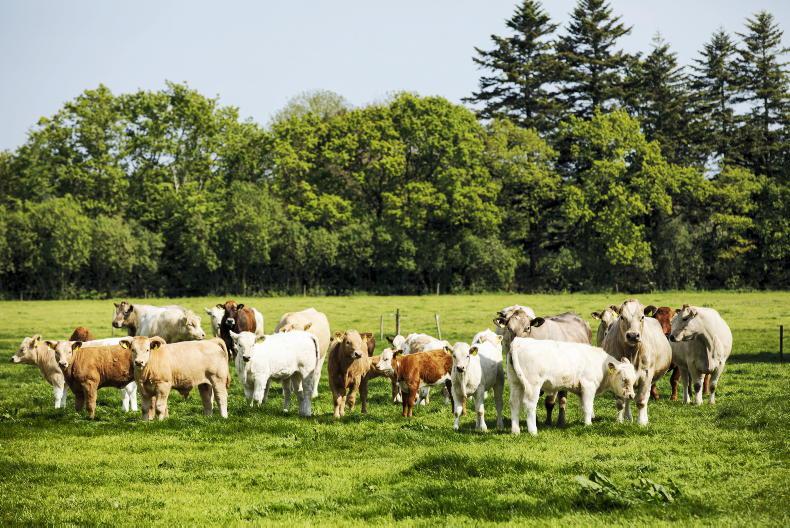The Suckler Carbon Efficiency Programme (SCEP) has come up for a lot of discussion in the last few weeks.
The changes that took place in the November evaluation have led to a huge amount of confusion as to what cows and bulls are SCEP-eligible and what animals aren’t SCEP-eligible.
The Department of Agriculture has moved to implement changes on the female replacement side and the AI bull side but has yet to make a decision on the pedigree bull issue.
Requirements of the programme
Action one:
eligible bull/eligible AI
In each scheme year, applicants must calve at least 50% beef-bred animals of the yearly reference number.
In scheme years one and two, 80% of these calves must have been sired from a four- or five-star source, ie a genotyped four- or five-star bull on either the terminal or replacement index (on a within or across breed basis), at the time of service and/or if using AI, and the AI straw used on participating holdings must be from a four- or five-star eligible bull on either the terminal or replacement index (on a within or across breed basis).

The changes that took place in the November evaluation have led to a huge amount of confusion as to what cows and bulls are SCEP-eligible.
In the event that an applicant calves more than the 50% requirement of their herd, these animals must also be sired from a four- or five-star source to a minimum of at least 80% of their yearly reference number. The target increases to 85% in years three and four of the programme and 90% in year five.
It’s important to note that sire discrepancies identified as a result of any genotyping performed during the programme will be resolved and where commitment is subsequently deemed to have not been achieved, the corresponding penalties will be applied.
For participants using rare breed sires, a derogation from the annual targets under this action may be granted in certain circumstances. Such requests should be made to the Beef Schemes division before 30 June each year of the programme.
Cows that are served this spring will be calving in scheme year three, so sires would need to be four- or five-star at some point since July 2023.
Bulls can qualify on the replacement or terminal index within or across breed. See Table 1.
Action two: female replacement strategy
Applicants are required to ensure that by 31 October 2023, at least 50% of their yearly reference number are eligible females that are genotyped four or five stars on the replacement index (on a within-breed or across-breed basis) at the time of purchase (for replacements brought into the herd) or at the time of genotyping (for those replacements bred within the herd).
This target increases to 65% by 31 October 2025 and 75% by 31 October 2027.
Genotyped females must be at least 16 months old on these dates.
Action three:
genotyping
Participants will be required to take a tissue tag sample from animals selected for genotyping as part of the programme. ICBF will select animals to be genotyped in each herd and will notify herd owners of the animals selected.
It may be possible for the herd owner to nominate animals for genotyping other than those selected by ICBF. The number of animals to be genotyped each year will be at least equivalent to 70% of the beneficiary’s “yearly reference number” (rounded down to the nearest animal).
For example, an applicant with a yearly reference of 10 must have sufficient animals to genotype seven females, calves or eligible bulls, without repetition of animals genotyped under the programme to date.
Tags are expected to be posted out to scheme applicants in midsummer for year one of the scheme.
Tags will be sent out in early spring in future years.
Samples must be returned by 30 November each year.
Action four: weighing
Participants must weigh at least 80% of eligible animals born on the holding of the yearly reference number in each scheme year, and their dams, and submit weights to ICBF.
Each live calf must be unweaned and weighed with its dam on the applicant’s holding on the same day.
Where a calf dies before five months of age or its dam dies, this must be recorded on AIM and the 80% does not include such pairs.
All calves being submitted for weighing must have been born in the herd within each scheme year.

If a cow departs your farm, a departure reason must also be given as part of the surveys. \ Claire Nash
The calf must be a minimum of 50 days old before it is eligible to be weighed.
Weights should be submitted within seven days of weighing and no later than 1 November annually.
Action five: calving details and surveys
In addition to meeting the statutory requirements for tagging and registration, programme applicants must complete the calving ease survey for each calf born on their farm.
All surveys for each scheme year must be submitted by 15 February the following year
Calf sire, calving ease, birth size and calf vigour must be recorded for each calf, along with calf quality, calf docility, dam docility, dam milk-ability, dam mothering ability, dam feet and legs, dam teat score and dam udder score.
If a cow departs your farm, a departure reason must also be given as part of the surveys.
All surveys for each scheme year must be submitted by 15 February the following year.
Once an animal was genotyped four- or five-star before the November 2023 evaluation run, this cow/heifer will still be eligible even if her index has dropped since the November run.
The animal has to stay in the SCEP participant’s herd for this rule to apply.
The next additional change that was made with female offspring of genotyped females in SCEP herds that do not become eligible for SCEP on their own genomic evaluation.
These may become eligible if their sire and dam meet a minimum requirement on the September 2023 ICBF evaluation. That is where the dam was three-, four- or five-star and the sire four- or five-star on the replacement index on a previous evaluation.

Participants must weigh at least 80% of eligible animals born on the holding of the yearly reference number in each scheme year. \ Donal O'Leary
This female offspring will be considered ‘SCEP eligible’ even if, when they are genotyped, they are not evaluated as four- or five-star in their own right.
Applicants must attend two SCEP training courses related to information on controls, inspections and sanctions in the SCEP and information on health and safety and livestock handling.
These courses must be completed by 15 November 2024 and failure to attend will result in removal from the programme.
No payment will be made to farmers for attending the training courses.
Payments will be made on a per-hectare basis with the first 15ha of the maximum payable area (MPA) being paid at €225/ha and the remainder being paid at €180/ha.
The number of eligible suckler cows that produced an eligible calf on the holding in the years 2016 to 2021 inclusive are provided by the Department at the application stage.
The applicant will be presented with the best three years of 2016 to 2021 and will receive the average of these three years as a reference number.
This reference number will be divided by 1.5 to give an MPA.
For example, a farmer with a reference number of 10 will have an MPA of 6.67ha. This farmer will be paid €1,500 of a total payment, or €150/cow.
Applicants with no data for the years 2016 to 2020 inclusive have been regarded as new entrants and will declare their programme and yearly reference number at application stage.
The same applies for suckler farmers who commenced operations in 2022 or early 2023.
You must set an annual reference number which can be 20% less than the previous year’s reference number.
This is to facilitate farmers who wish to reduce their cow numbers over the duration of the five-year programme and still remain in the programme.
In order to avail of the full payment, an applicant must have at least enough determined eligible forage hectares under their BISS application each year to match their MPA.
If the determined eligible forage area is less than the MPA but 80% or above, the payment will be based on this eligible forage area.
It’s important to note that failure to remain in the Bord Bia quality assurance scheme for the five years of the programme will result in a full clawback of monies paid out as part of the scheme.
The Suckler Carbon Efficiency Programme (SCEP) has come up for a lot of discussion in the last few weeks.
The changes that took place in the November evaluation have led to a huge amount of confusion as to what cows and bulls are SCEP-eligible and what animals aren’t SCEP-eligible.
The Department of Agriculture has moved to implement changes on the female replacement side and the AI bull side but has yet to make a decision on the pedigree bull issue.
Requirements of the programme
Action one:
eligible bull/eligible AI
In each scheme year, applicants must calve at least 50% beef-bred animals of the yearly reference number.
In scheme years one and two, 80% of these calves must have been sired from a four- or five-star source, ie a genotyped four- or five-star bull on either the terminal or replacement index (on a within or across breed basis), at the time of service and/or if using AI, and the AI straw used on participating holdings must be from a four- or five-star eligible bull on either the terminal or replacement index (on a within or across breed basis).

The changes that took place in the November evaluation have led to a huge amount of confusion as to what cows and bulls are SCEP-eligible.
In the event that an applicant calves more than the 50% requirement of their herd, these animals must also be sired from a four- or five-star source to a minimum of at least 80% of their yearly reference number. The target increases to 85% in years three and four of the programme and 90% in year five.
It’s important to note that sire discrepancies identified as a result of any genotyping performed during the programme will be resolved and where commitment is subsequently deemed to have not been achieved, the corresponding penalties will be applied.
For participants using rare breed sires, a derogation from the annual targets under this action may be granted in certain circumstances. Such requests should be made to the Beef Schemes division before 30 June each year of the programme.
Cows that are served this spring will be calving in scheme year three, so sires would need to be four- or five-star at some point since July 2023.
Bulls can qualify on the replacement or terminal index within or across breed. See Table 1.
Action two: female replacement strategy
Applicants are required to ensure that by 31 October 2023, at least 50% of their yearly reference number are eligible females that are genotyped four or five stars on the replacement index (on a within-breed or across-breed basis) at the time of purchase (for replacements brought into the herd) or at the time of genotyping (for those replacements bred within the herd).
This target increases to 65% by 31 October 2025 and 75% by 31 October 2027.
Genotyped females must be at least 16 months old on these dates.
Action three:
genotyping
Participants will be required to take a tissue tag sample from animals selected for genotyping as part of the programme. ICBF will select animals to be genotyped in each herd and will notify herd owners of the animals selected.
It may be possible for the herd owner to nominate animals for genotyping other than those selected by ICBF. The number of animals to be genotyped each year will be at least equivalent to 70% of the beneficiary’s “yearly reference number” (rounded down to the nearest animal).
For example, an applicant with a yearly reference of 10 must have sufficient animals to genotype seven females, calves or eligible bulls, without repetition of animals genotyped under the programme to date.
Tags are expected to be posted out to scheme applicants in midsummer for year one of the scheme.
Tags will be sent out in early spring in future years.
Samples must be returned by 30 November each year.
Action four: weighing
Participants must weigh at least 80% of eligible animals born on the holding of the yearly reference number in each scheme year, and their dams, and submit weights to ICBF.
Each live calf must be unweaned and weighed with its dam on the applicant’s holding on the same day.
Where a calf dies before five months of age or its dam dies, this must be recorded on AIM and the 80% does not include such pairs.
All calves being submitted for weighing must have been born in the herd within each scheme year.

If a cow departs your farm, a departure reason must also be given as part of the surveys. \ Claire Nash
The calf must be a minimum of 50 days old before it is eligible to be weighed.
Weights should be submitted within seven days of weighing and no later than 1 November annually.
Action five: calving details and surveys
In addition to meeting the statutory requirements for tagging and registration, programme applicants must complete the calving ease survey for each calf born on their farm.
All surveys for each scheme year must be submitted by 15 February the following year
Calf sire, calving ease, birth size and calf vigour must be recorded for each calf, along with calf quality, calf docility, dam docility, dam milk-ability, dam mothering ability, dam feet and legs, dam teat score and dam udder score.
If a cow departs your farm, a departure reason must also be given as part of the surveys.
All surveys for each scheme year must be submitted by 15 February the following year.
Once an animal was genotyped four- or five-star before the November 2023 evaluation run, this cow/heifer will still be eligible even if her index has dropped since the November run.
The animal has to stay in the SCEP participant’s herd for this rule to apply.
The next additional change that was made with female offspring of genotyped females in SCEP herds that do not become eligible for SCEP on their own genomic evaluation.
These may become eligible if their sire and dam meet a minimum requirement on the September 2023 ICBF evaluation. That is where the dam was three-, four- or five-star and the sire four- or five-star on the replacement index on a previous evaluation.

Participants must weigh at least 80% of eligible animals born on the holding of the yearly reference number in each scheme year. \ Donal O'Leary
This female offspring will be considered ‘SCEP eligible’ even if, when they are genotyped, they are not evaluated as four- or five-star in their own right.
Applicants must attend two SCEP training courses related to information on controls, inspections and sanctions in the SCEP and information on health and safety and livestock handling.
These courses must be completed by 15 November 2024 and failure to attend will result in removal from the programme.
No payment will be made to farmers for attending the training courses.
Payments will be made on a per-hectare basis with the first 15ha of the maximum payable area (MPA) being paid at €225/ha and the remainder being paid at €180/ha.
The number of eligible suckler cows that produced an eligible calf on the holding in the years 2016 to 2021 inclusive are provided by the Department at the application stage.
The applicant will be presented with the best three years of 2016 to 2021 and will receive the average of these three years as a reference number.
This reference number will be divided by 1.5 to give an MPA.
For example, a farmer with a reference number of 10 will have an MPA of 6.67ha. This farmer will be paid €1,500 of a total payment, or €150/cow.
Applicants with no data for the years 2016 to 2020 inclusive have been regarded as new entrants and will declare their programme and yearly reference number at application stage.
The same applies for suckler farmers who commenced operations in 2022 or early 2023.
You must set an annual reference number which can be 20% less than the previous year’s reference number.
This is to facilitate farmers who wish to reduce their cow numbers over the duration of the five-year programme and still remain in the programme.
In order to avail of the full payment, an applicant must have at least enough determined eligible forage hectares under their BISS application each year to match their MPA.
If the determined eligible forage area is less than the MPA but 80% or above, the payment will be based on this eligible forage area.
It’s important to note that failure to remain in the Bord Bia quality assurance scheme for the five years of the programme will result in a full clawback of monies paid out as part of the scheme.









 This is a subscriber-only article
This is a subscriber-only article










SHARING OPTIONS: